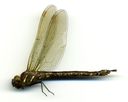Darners
Aeshnidae
Classification
- Phylum: Arthropoda
- Subphylum: Hexapoda
- Class: Insecta
- Order: Odonata
- Suborder: Anisoptera
- Family: Aeshnidae
Pronunciation
How to pronounce Aeshnidae: //ˈiʃnɪdiː//
These audio files are automatically generated. While they are not always 100% accurate, they are a good starting point.
Images






Summary
Aeshnidae, or darners, are a family of large dragonflies prevalent in various habitats worldwide, known for their impressive flying abilities and ecological role as insect predators. They are characterized by their long abdomens and remarkable vision, playing significant roles in controlling insect populations.
Physical Characteristics
Darners typically possess long and slender abdomens, with many exhibiting blue and green coloration, accented by black and, occasionally, yellow. Their compound eyes are large and hemispherical, touching in the midline of the head, which helps provide them with excellent vision.
Identification Tips
Look for long, thin abdomens and large, horizontally extended wings. The coloration may include vibrant blues and greens, as well as distinct black markings. The characteristic 'needle-like' appearance of female abdomens is notable during oviposition.
Habitat
Darners are commonly found near freshwater bodies, including ponds, lakes, and streams where they deposit their eggs in water or on vegetation near water.
Distribution
Darners have a nearly worldwide distribution, with notable populations in North America, Europe, Asia, and Africa. There are 41 North American species across 11 genera.
Diet
Darners are voracious insect predators, primarily consuming other flying insects such as mosquitoes and flies, as well as smaller fish during their larval stage.
Life Cycle
Darners undergo complete metamorphosis, beginning with aquatic larvae (nymphs), which develop in water before emerging as adults. The larvae are generally slender with a long extensible labium for capturing prey.
Reproduction
Darners mate in flight, and females lay their eggs in water or on wet substrates. The female's ovipositor is adapted for cutting into plant stems during egg-laying.
Ecosystem Role
Darners play a significant role as predators of nuisance insects, like mosquitoes, contributing to pest control in their ecosystems.
Economic Impact
Their predatory habits are beneficial for controlling insect populations that can affect human health and agriculture.
Collecting Methods
- Netting during flight
- Using traps near water bodies
Preservation Methods
- Pinning
- Ethanol preservation
Evolution
The Aeshnidae family was first described by Elford Leach in 1815, and the name may stem from a printer's error related to the Greek word for 'spear.'
Similar Taxa
Misconceptions
Some people may confuse darners with other dragonflies due to their size and coloration, or may believe they are a nuisance when, in fact, they are beneficial for pest control.
Tags
- dragonflies
- Aeshnidae
- insecta
- predators
- ecosystem
- North America
- evolution